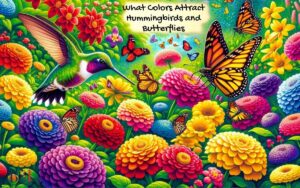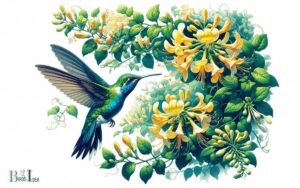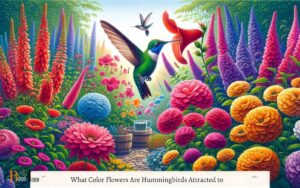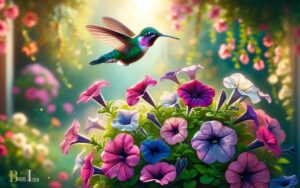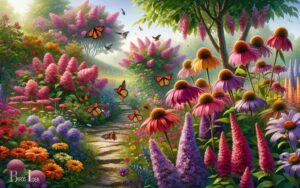Climbing Plants That Attract Hummingbirds: Discover!
Climbing plants like trumpet vine (Campsis radicans), honeysuckle (Lonicera spp.), and clematis (Clematis spp.) are fantastic for attracting hummingbirds. Their vibrant flowers provide nectar, which is a primary food source for these birds.
Other climbing plants such as passionflower (Passiflora spp.) and morning glory (Ipomoea spp.) also have the potential to draw hummingbirds into your garden with their colorful and tubular blooms that are perfect for feeding.
Some climbing plants that attract hummingbirds include:
By integrating climbing plants you not only elevate its aesthetic appeal but also invite the delightful presence of hummingbirds with their dazzling aerial displays.
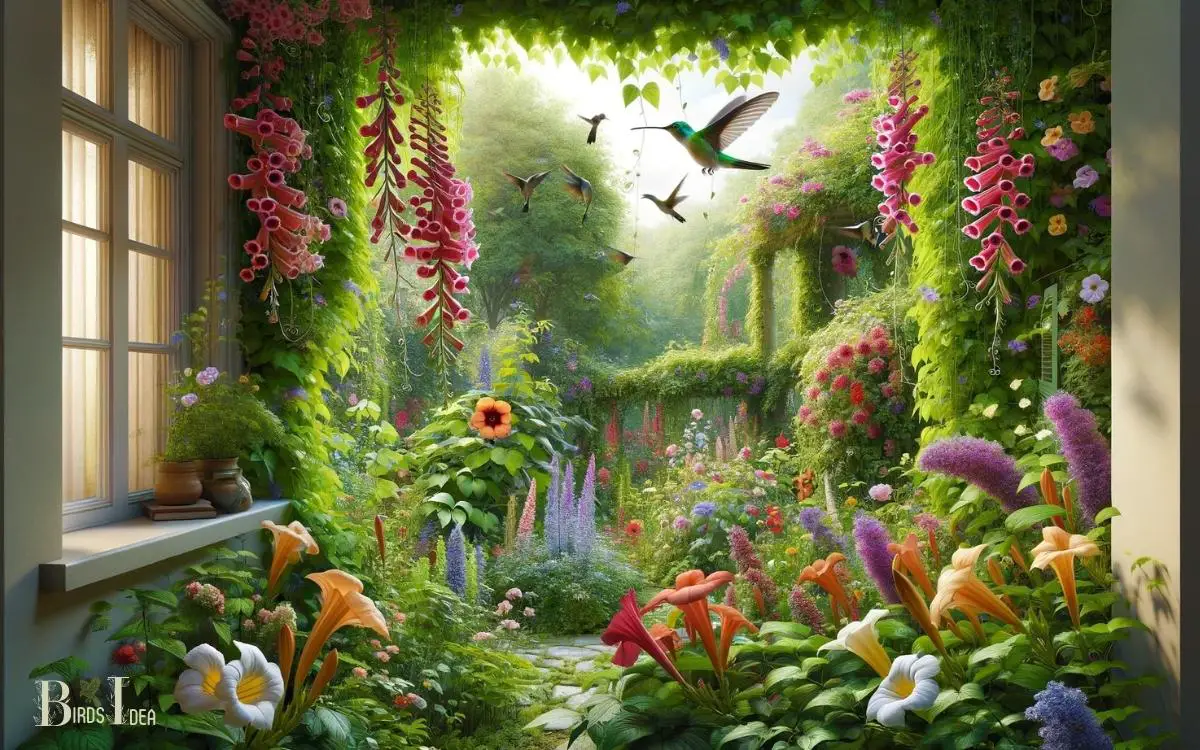
Key Takeaway
Trumpet Vine (Campsis Radicans)
The Trumpet Vine attracts hummingbirds with its vibrant red flowers and abundant nectar. These climbing plants are known for their ability to thrive in various soil types and climates, making them a popular choice for gardeners looking to attract hummingbirds.
Trumpet Vines can grow rapidly, reaching heights of up to 40 feet, and their trumpet-shaped flowers bloom profusely during the summer, providing an enticing food source for hummingbirds.
While they are low-maintenance once established, it’s important to note that their aggressive growth habit may require regular pruning to prevent them from overtaking other plants.
Gardeners should also consider their potential for spreading via underground runners and should monitor their growth to prevent them from becoming invasive.
Coral Honeysuckle (Lonicera Sempervirens)
Coral honeysuckle, also known as Lonicera Sempervirens, is a popular choice for attracting hummingbirds due to its vibrant tubular flowers.
This climbing plant is characterized by its ability to thrive in a variety of soil types and its adaptability to both sun and partial shade.
Its long bloom period throughout the summer makes it a reliable source of nectar for hummingbirds.
Hummingbird-Friendly Climbing Plants
Hummingbirds are attracted to the Coral Honeysuckle (Lonicera Sempervirens) due to its vibrant flowers and nectar-filled blossoms.
This climbing plant is an excellent choice for attracting hummingbirds to the garden due to its characteristics:
- Vibrant Flowers: The Coral Honeysuckle produces tubular, coral-red flowers that are irresistible to hummingbirds.
- Abundant Nectar: The plant’s nectar-filled blossoms provide a rich and easily accessible food source for hummingbirds.
- Easy Maintenance: Coral Honeysuckle is relatively low-maintenance and can thrive in various soil types and light conditions.
- Versatile Climber: It can be trained to climb on trellises, fences, or arbors, adding a beautiful vertical element to the garden.
These features make Coral Honeysuckle an attractive option for gardeners looking to create a hummingbird-friendly environment.
Lonicera Sempervirens Characteristics
Lonicera Sempervirens, also known as Coral Honeysuckle, is characterized by its vibrant tubular flowers and abundant nectar, making it a highly attractive option for hummingbird enthusiasts.
This climbing plant is native to the southeastern United States and is a perennial favorite due to its low maintenance and wildlife-attracting capabilities.
The trumpet-shaped, coral-red flowers of the Lonicera Sempervirens bloom from spring to fall, providing a long-lasting food source for hummingbirds.
Its ability to thrive in various soil types, including rocky and clay soils, makes it adaptable to different garden environments.
Additionally, the Coral Honeysuckle is known for its attractive foliage, featuring pairs of oblong leaves that remain green throughout the year.
Its resilience, coupled with its aesthetic and wildlife benefits, makes it a sought-after choice for gardens aiming to attract hummingbirds.
Morning Glory
Morning Glory (Ipomoea) is a genus of flowering plants that includes many species known for their colorful and trumpet-shaped flowers.
While Morning Glory flowers are not typically considered a primary source of nectar for hummingbirds, some species may attract these birds to a certain extent.
Hummingbirds are generally attracted to tubular-shaped flowers with bright colors, especially red, orange, or pink.
Morning Glory flowers, depending on the specific species and variety, may have tubular-shaped blossoms that could catch the attention of hummingbirds.
However, it’s important to note that Morning Glory flowers are not among the top choices for hummingbirds compared to other plants like bee balm, salvia, or trumpet vine, which are known for their hummingbird-friendly characteristics.
Climbing Snapdragon (Maurandya Antirrhiniflora)
The Climbing Snapdragon, also known as Maurandya Antirrhiniflora, is a delightful addition to any garden seeking to attract hummingbirds.
With its vibrant, trumpet-shaped flowers, it provides a stunning visual appeal while also serving as a nectar source for these tiny birds.
Gardeners can benefit from valuable growing tips to ensure the successful cultivation of this hummingbird-friendly plant.
Hummingbird-Friendly Climbing Snapdragon
Known for its delicate flowers and ability to attract hummingbirds, the climbing snapdragon (Maurandya Antirrhiniflora) is a popular choice for gardeners seeking to create a hummingbird-friendly environment.
This charming climbing plant offers several benefits, including:
- Continuous Blooms: The climbing snapdragon produces an abundance of colorful, tube-shaped flowers throughout the growing season.
- Low Maintenance: It requires minimal care and is relatively pest-resistant, making it an ideal choice for busy gardeners.
- Versatile Growth: It can thrive in various conditions, including containers, hanging baskets, or as a ground cover.
- Attracts Hummingbirds: The nectar-rich flowers are irresistible to hummingbirds, adding lively movement and vibrant energy to the garden.
Growing Tips for Snapdragon
Climbing snapdragons require well-draining soil and full sunlight to thrive, making them an excellent addition to any hummingbird-friendly garden.
When planting climbing snapdragons, it’s essential to choose a location with fertile, well-draining soil.
These plants prefer full sunlight but can tolerate partial shade. They should be watered regularly, especially during dry spells, but it’s crucial to avoid overwatering as they are susceptible to root rot.
Climbing snapdragons benefit from a layer of mulch to retain moisture and control weeds. Supporting structures, such as trellises or fences, are necessary for them to climb and flourish.
Regular pruning encourages bushier growth and more abundant flowering. Additionally, providing a balanced fertilizer during the growing season can further enhance their growth and blooming.
Attracting Hummingbirds With Snapdragon
Snapdragons (Maurandya antirrhiniflora) are an excellent choice for attracting hummingbirds to the garden due to their vibrant flowers and nectar-producing qualities.
With their climbing nature, they create a beautiful vertical display while serving as a natural magnet for hummingbirds.
Here’s why snapdragons are a great addition to any garden seeking to attract hummingbirds:
- Vibrant Flowers: Snapdragons produce colorful, tubular-shaped flowers that hummingbirds find irresistible.
- Continuous Blooms: These plants offer a long blooming season, ensuring a steady nectar supply for hummingbirds.
- Adaptable: Snapdragons can thrive in various soil types and light conditions, making them versatile for different garden environments.
- Low Maintenance: They require minimal care and are relatively easy to grow, making them suitable for both experienced and novice gardeners.
When considering climbing plants to attract hummingbirds, snapdragons are a fantastic option.
Crossvine (Bignonia Capreolata)
Crossvine, a vigorous vine native to the southeastern United States, is a popular choice for attracting hummingbirds to the garden.
Its trumpet-shaped flowers in shades of red, orange, and yellow are a magnet for these delightful, tiny birds.
The table below provides a quick overview of the key characteristics of Crossvine.
| Aspect | Description |
|---|---|
| Growth Rate | Fast |
| Sun Exposure | Full sun to part shade |
| Soil | Well-draining |
| Bloom Time | Spring to early summer |
| Hummingbird Attraction | High |
Crossvine’s rapid growth and ability to thrive in various light conditions make it an excellent option for trellises, fences, and arbors. Its early blooming period provides a vital nectar source for hummingbirds as they arrive from their migration.
With its attractive foliage and vibrant blooms, Crossvine is a valuable addition to any garden seeking to attract these enchanting birds.
Dutchman’s Pipe (Aristolochia Macrophylla)
Dutchman’s Pipe, also known as Aristolochia Macrophylla, is a climbing plant that is highly attractive to hummingbirds due to its unique, pipe-shaped flowers.
The flowers of the Dutchman’s Pipe produce a musty odor that mimics the scent of decaying matter, which is appealing to flies.
This clever adaptation serves to attract pollinators, including hummingbirds, that are drawn to the scent.
Here are some key features of Dutchman’s Pipe:
- Large Leaves: Dutchman’s Pipe has large, heart-shaped leaves that provide ample shade and shelter for hummingbirds.
- Vining Habit: Its vining habit makes it an excellent choice for arbors, fences, and trellises in gardens.
- Native to Eastern North America: This plant is native to the eastern United States and is well-suited to the climate and soil conditions of the region.
- Low Maintenance: Dutchman’s Pipe is relatively low maintenance, making it a practical choice for gardeners seeking to attract hummingbirds.
Dutchman’s Pipe is an intriguing and practical addition to any garden seeking to attract these delightful birds.
Chilean Glory Flower (Eccremocarpus Scaber)
The Chilean Glory Flower, known scientifically as Eccremocarpus Scaber, is a climbing plant that is notable for its vibrant, tubular flowers.
This South American native is a favorite among hummingbirds due to its nectar-rich blooms. The Chilean Glory Flower is a vigorous climber, making it an excellent choice for covering walls, fences, or trellises.
It prefers well-drained soil and a sunny location, thriving in USDA hardiness zones 8-11. This plant’s ability to attract hummingbirds makes it a delightful addition to any garden seeking to invite these charming creatures.
Gardeners should provide support for its climbing habit and deadhead spent flowers to encourage continuous blooming.
With its striking flowers and ability to entice hummingbirds, the Chilean Glory Flower is a captivating choice for any hummingbird garden.
Climbing Bleeding Heart (Dicentra Scandens)
Dicentra Scandens climbs with delicate tendrils, drawing hummingbirds with its dangling, heart-shaped flowers.
This climbing plant is a beautiful addition to any garden that seeks to attract these tiny, vibrant birds.
Here are some key points about Climbing Bleeding Heart:
- Native Habitat: Found in woodlands and forest edges, it thrives in partially shaded areas.
- Growing Conditions: It prefers moist, well-drained soil and can tolerate various soil types.
- Flowering: The stunning, pendulous pink flowers bloom from late spring to early summer.
- Hummingbird Attraction: The nectar-filled blooms are irresistible to hummingbirds, making it a delightful addition to a hummingbird-friendly garden.
Climbing Bleeding Heart’s graceful vines and charming flowers make it a perfect choice for both gardeners and hummingbird enthusiasts.
Conclusion
These captivating climbing plants can create a colorful and charming haven for hummingbirds in your garden.
With their trumpet-shaped blooms and vibrant colors, they can entice and enchant these delightful birds, bringing joy and jubilation to your outdoor space.
So, plant these picturesque and pleasing plants to bring the beauty and buzz of hummingbirds into your yard.

